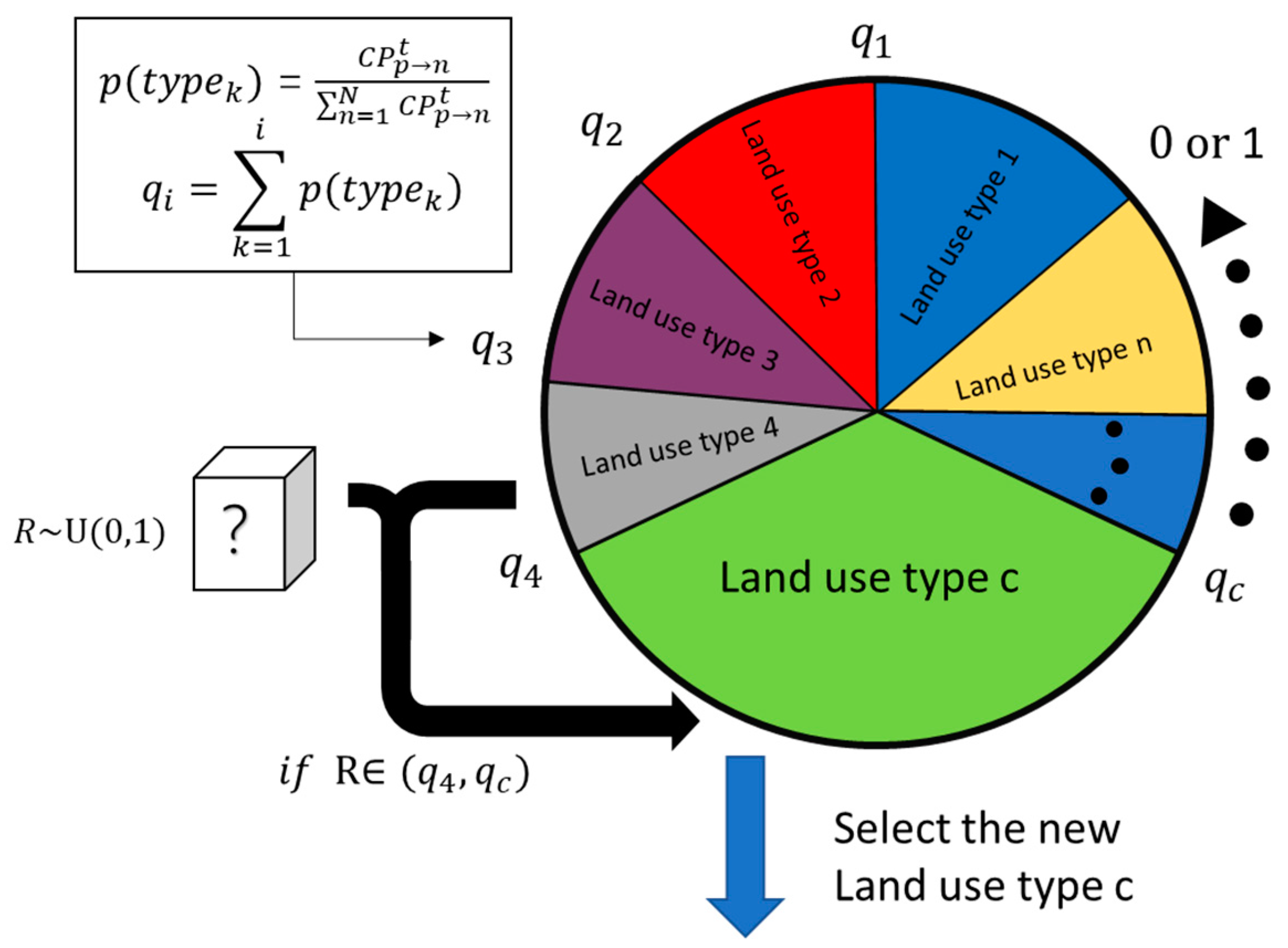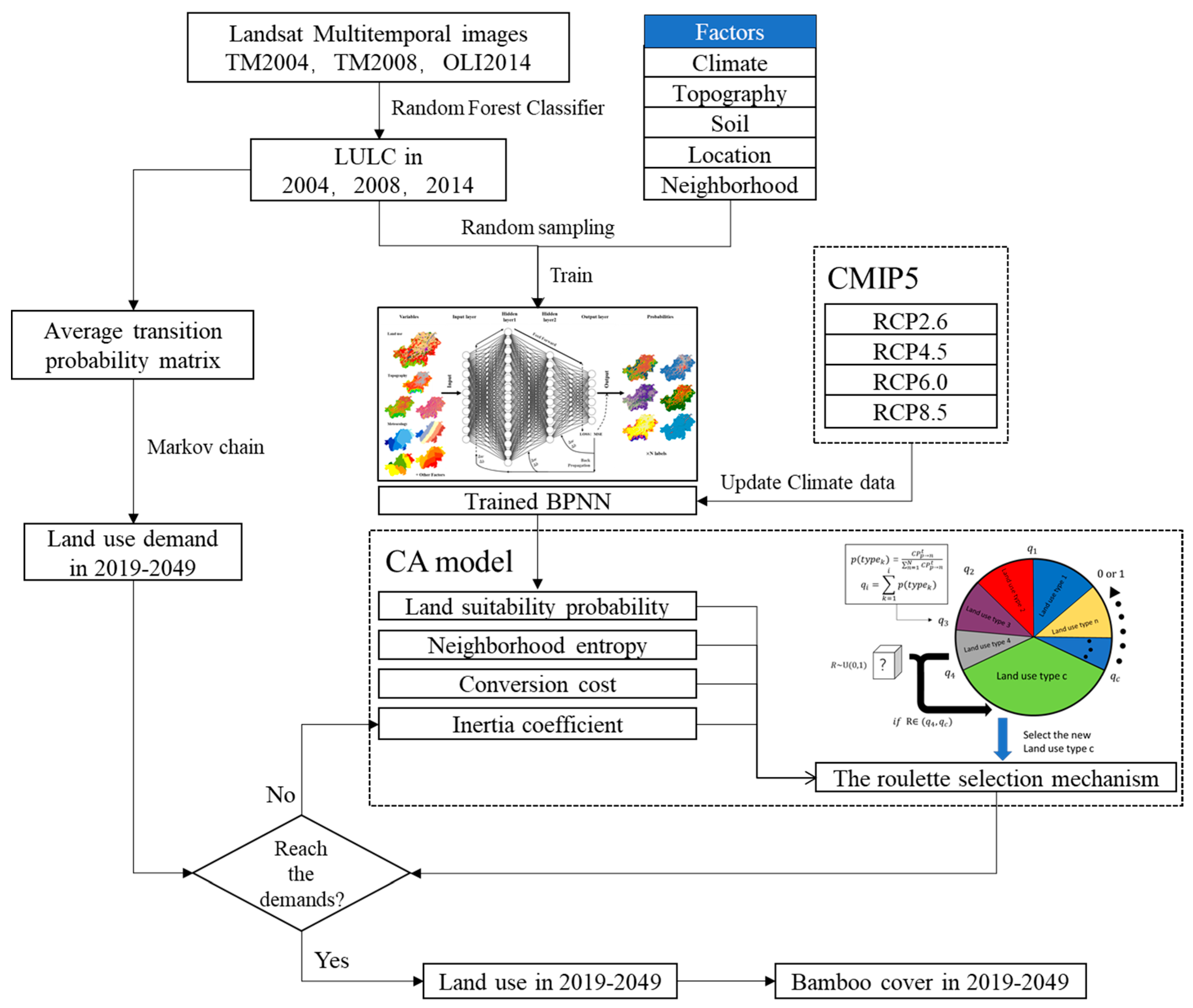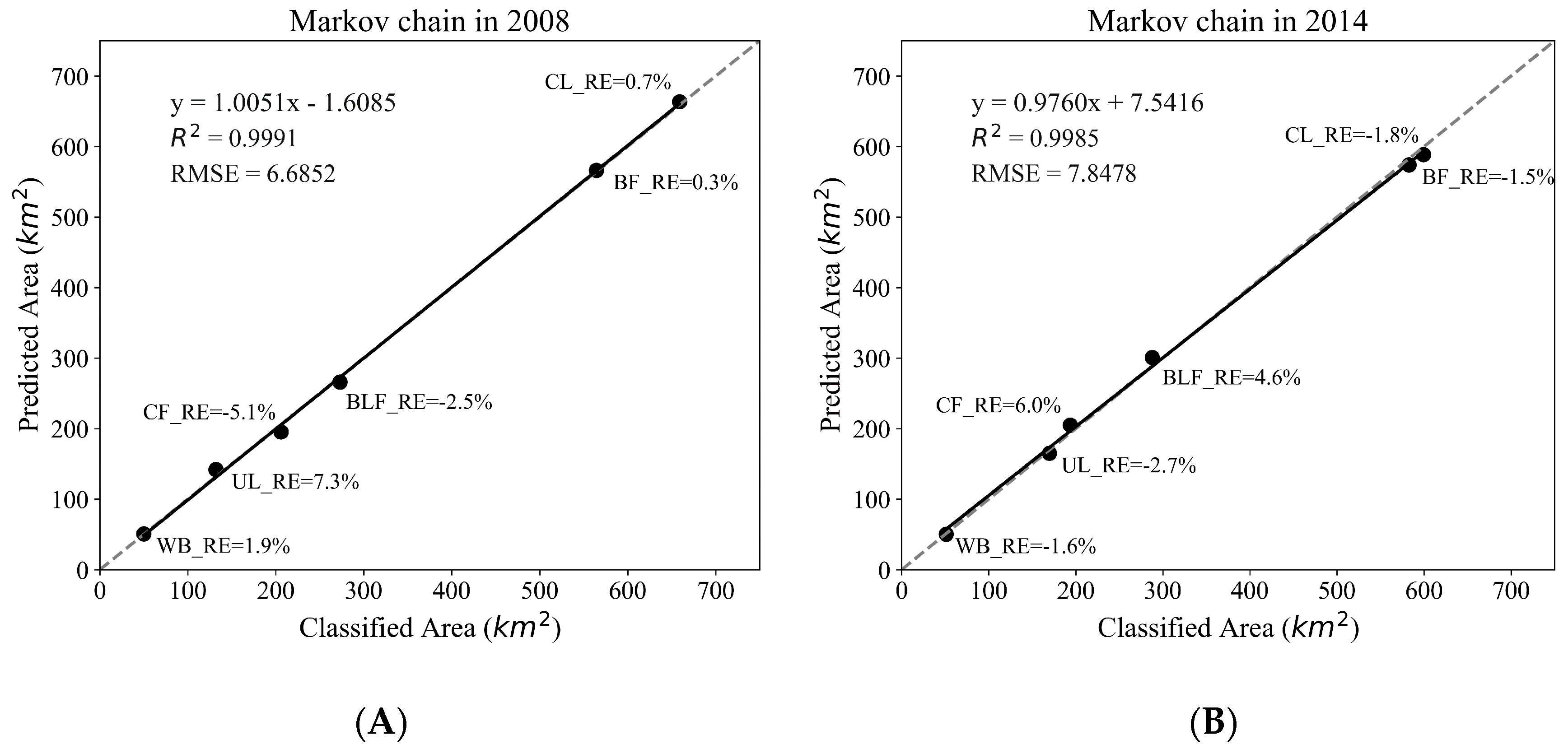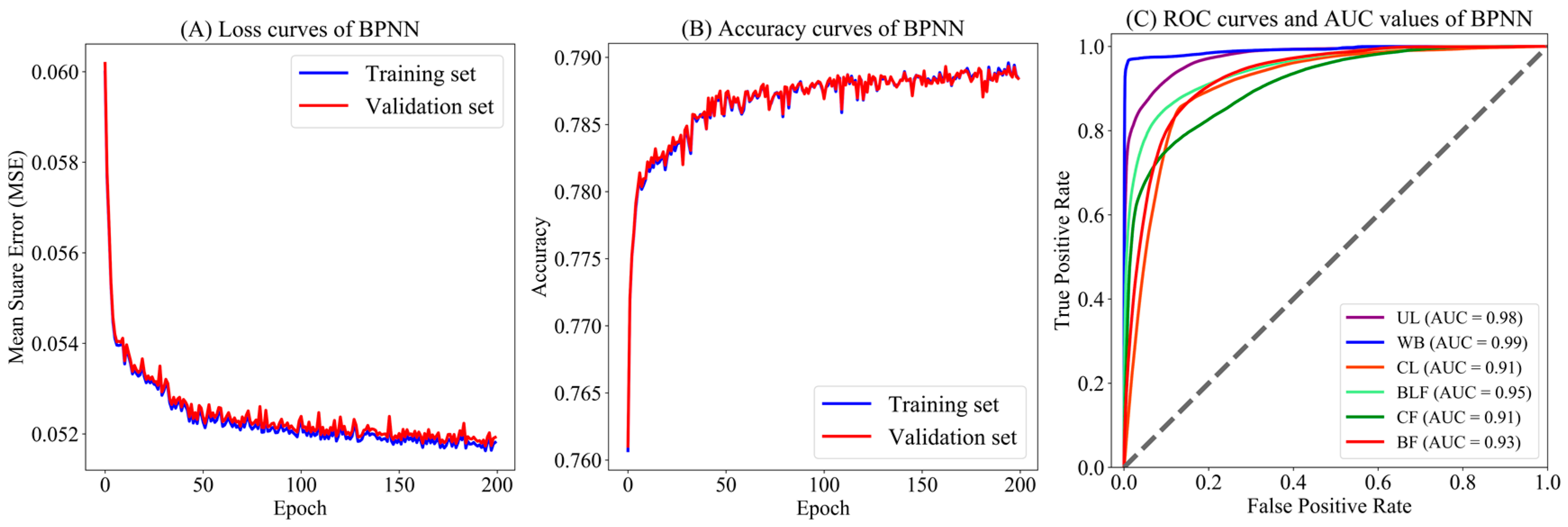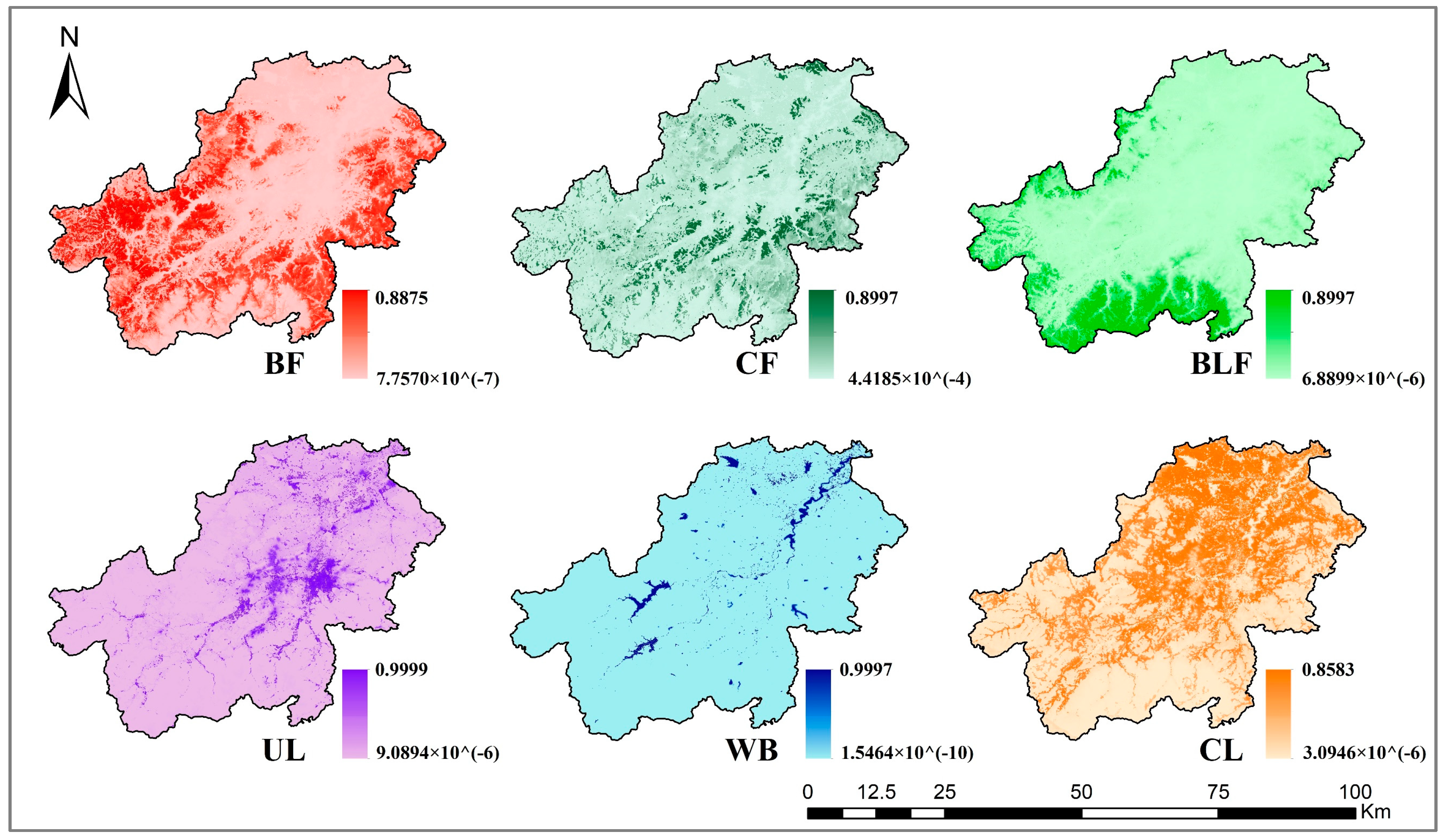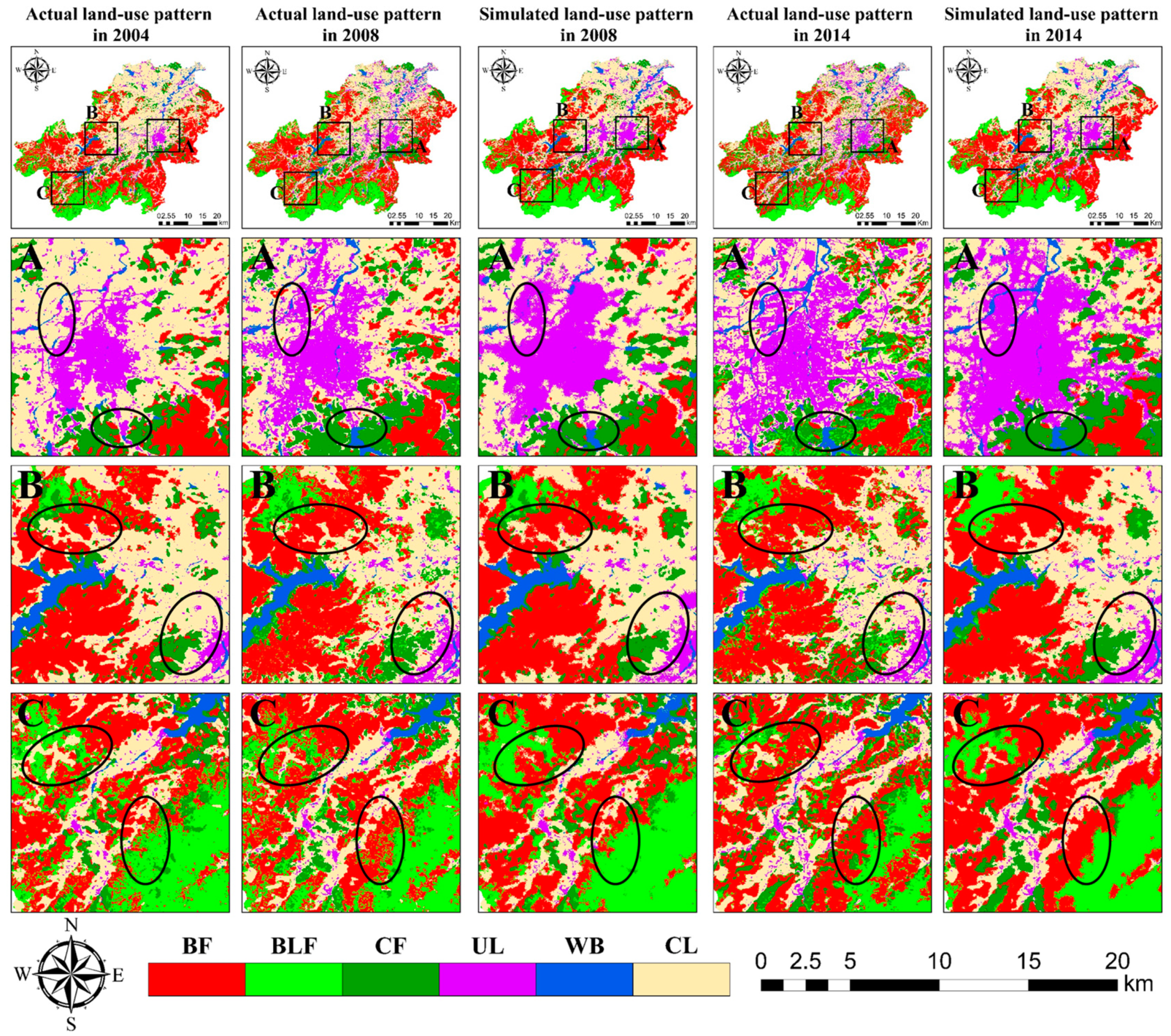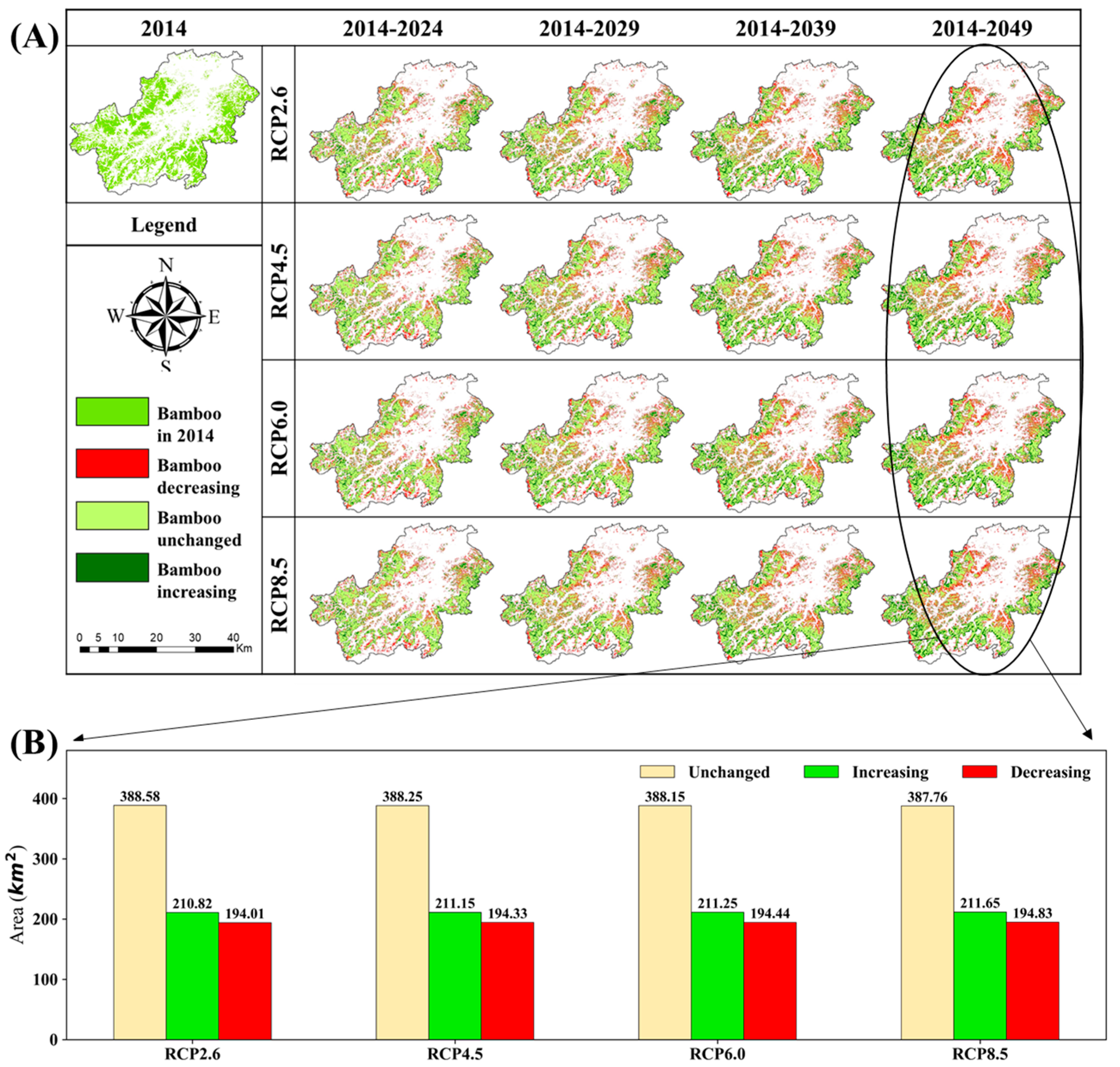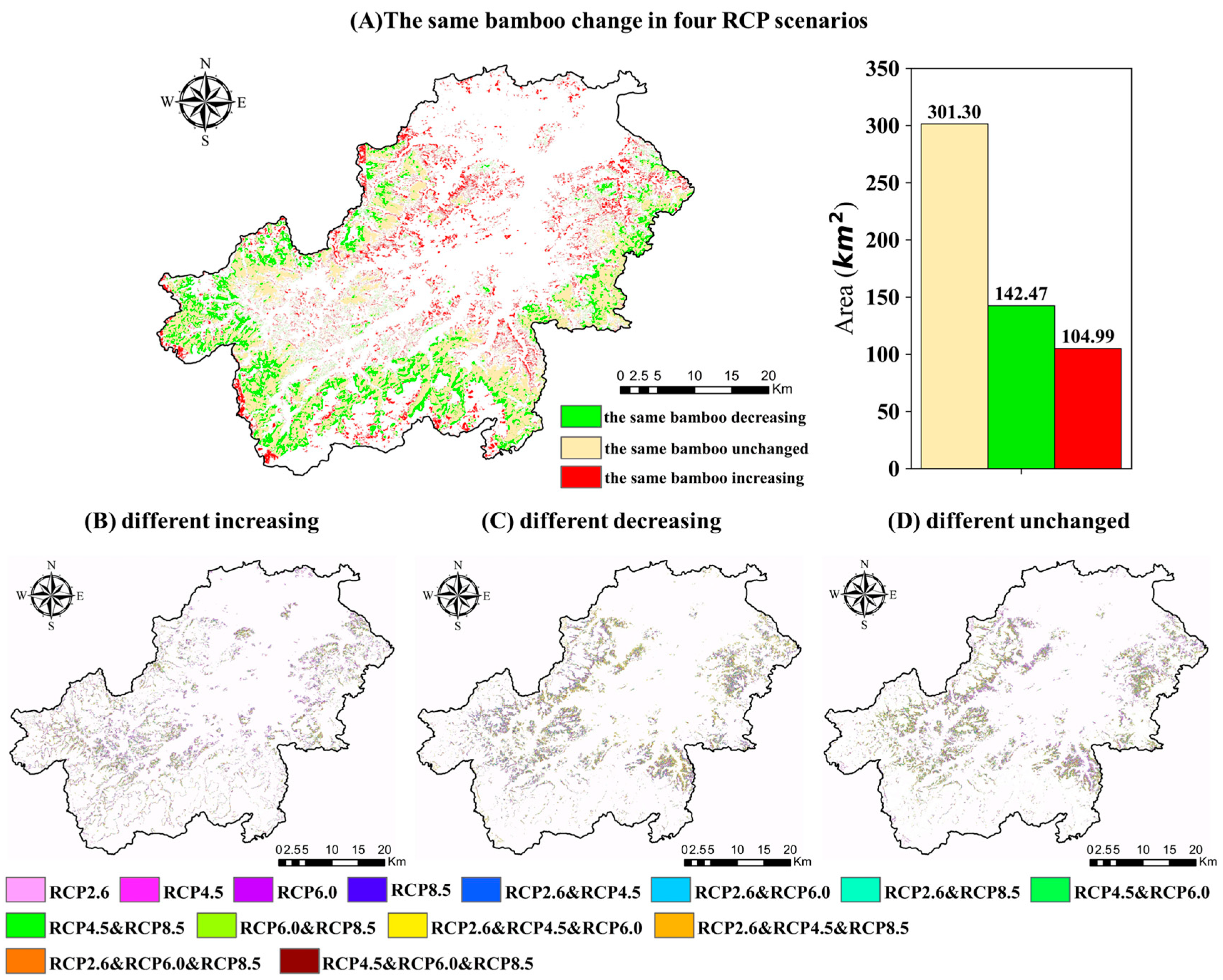1. Introduction
Land use and land cover change (LUCC) is a direct driving factor affecting the carbon balance of terrestrial ecosystems, and its impact on global warming is second only to that of fossil fuels and industrial emissions [
1,
2,
3]. The Fifth Assessment Report (AR5) produced by the Intergovernmental Panel on Climate Change (IPCC) further noted that the emissions caused by forest reduction and land-use changes are as high as 180 billion tons of carbon, accounting for 33% of the cumulative anthropogenic CO
2 emissions. Therefore, the role of land-use plans such as reforestation in mitigating climate change has been widely recognized [
4]. However, the impact of climate change and LUCC on the temporal and spatial dynamics of forests has also received attention [
5]. Limited LUCC data cause considerable underestimations regarding the impact of LUCC on carbon emissions [
6]. The lack of spatiotemporal LUCC data under the background of the future climate is an important limitation we must overcome if we are to reveal the response of the carbon cycle of forest ecosystems to future climate change. Therefore, simulating spatiotemporal LUCC data accurately under future climate scenarios and probing the spatial evolution trajectories of LUCC has important scientific significance for revealing the response of the forest ecosystem carbon cycle to LUCC. Accurate LUCC simulation is proposed under the background that LUCC affects the carbon budget of terrestrial ecosystems, and global climate change has an urgent need for information on the regional and global future land-use spatiotemporal evolution patterns [
7].
At present, spatiotemporal LUCC simulation mainly includes the simulation of quantity changes and spatial distribution changes. There are many models for these two situations, and these models can be roughly divided into three types: quantitative models, spatial models, and coupling models of quantitative and spatial models. Quantitative models focus on the analysis of the area change and rate of change of each land-use type, including the gray correlation, Markov chain, logistic regression, and system dynamic models [
8,
9,
10]. Gobin et al. [
11] used a logistic regression model to predict the quantity of agricultural land in southeastern Nigeria. Tian et al. [
12] projected China’s land-use demand under different scenarios from 2010 to 2050 based on the system dynamic model. Spatial models that mainly include the cellular automata (CA) model, the conversion of land use and its effects at small regional extent (CLUE-S) model and Geomod model, combine remote sensing and geographic information system technology to overcome the shortcomings of quantitative models regarding the spatial scale, and could be used to reveal the LUCC and its interrelationships on different temporal and spatial scales [
13,
14,
15,
16]. However, the efficiency of some spatial models, such as the CLUE-S model, is not satisfactory because the model must rely on relevant results provided by quantitative models to make reasonable predictions for various land-use types [
17,
18].
The single model described above does not fully consider the internal mechanism of the ecosystem when simulating LUCC. Therefore, to improve the accuracy of the simulation, the coupling of the quantitative model and the spatial model has become a popular method for accurately predicting the spatiotemporal pattern of LUCC [
19]. The research results of Leemans et al. and Meijl et al. [
20,
21] both indicate that the coupled model is more advantageous in simulating the state of LUCC under different scenarios. Meanwhile, the CA and the Markov chain coupling model (CA_Markov) are found to be the most universal and effective models in predicting future LUCC dynamics under various scenarios [
22,
23,
24,
25]. Wu et al. [
5] simulated forest landscape dynamics of Taihe County by integrating CA_Markov and a forest landscape model for 2010 to 2050. Zhao et al. [
26] linked the CA_Markov and Invest models to effectively assess the potential effects of ecological engineering on carbon storage. In these studies, the Markov chain model controls the area change between land-use types by the transition probability matrix [
27]. The CA model controls the spatial pattern changes by considering factors such as land suitability and neighborhood effects; thus, the use of appropriate methods to determine land suitability is also one of the keys to LUCC simulation [
28]. With the development of artificial intelligence, the combination of artificial neural networks and CA models to determine land suitability and simulate the temporal and spatial evolution of land use has attracted increasing attention [
7,
13,
29]. A future land-use simulation (FLUS) consisting of an artificial neural network and CA model could be applied to the effective LUCC prediction of four scenarios from 2010 to 2050 that depict different development strategies by considering various socioeconomic and natural climatic factors [
7]. Considering that the performance of the back propagation neural network (BPNN) is better than some artificial neural networks, the CA model integrated with the BPNN (BPNN_CA) can be designed to control the spatial pattern changes more precisely.
Global forests are under tremendous pressure from various natural and anthropogenic disturbances [
30,
31] that have resulted in forest loss and degradation over the past 20 years [
5,
32]. As efficient and reproducible tools, spatiotemporal LUCC simulations can analyze both the origins and consequences of future landscape dynamics relative to anthropogenic and natural environmental driving forces [
33,
34]. The complex structure of linkages and feedback will be assessed by using simulation models to predict future LUCC trajectories [
35,
36]. Bamboo forest is a special type of forest in the subtropical zone that has a high-efficiency carbon sequestration capacity and a strong carbon sink potential. Currently, the bamboo forest area in China, which is a veritable “world bamboo kingdom”, has reached more than 6.41 million hectares, accounting for approximately 20% of the world’s bamboo forest area; thus, it has played an important role in how regional forests respond to climate change [
37]. The area of bamboo forests in China has grown at an alarming rate, with an increase of approximately 52% in the past 20 years. Furthermore, the potential suitable areas for bamboo forests in China show range contractions towards interior China and expansions towards southwestern China under future climate scenarios [
38]. However, due to the unclear relationship between bamboo forests and other land-use types under the current climate change background, exploring the spatiotemporal evolution of bamboo forests under the background to grasp the competitive relationship between bamboo forests and other land-use types under the LUCC driving forces has important scientific significance for bamboo forests in terms of how they adapt to climate change and how we evaluate its contribution to the carbon balance of regional ecosystems.
Anji County is the famous bamboo hometown of Zhejiang Province in China. In recent years, the area of bamboo forests in the county has continued to increase, and its impacts on forest types and carbon cycles have been a concern [
39,
40]. Therefore, based on past and current remote sensing information, this study takes Anji County as an example and uses the BPNN_CA_Markov coupling model to simulate the LUCC under the Representative Concentration Pathway (RCP) 2.6, 4.5, 6.0, and 8.5 (RCP2.6, 4.5, 6.0, 8.5) scenarios from 2024 to 2049. The objectives of our research are mainly as follows: (1) to build a Markov chain model to predict the land-use demand in the study area in a certain future period; (2) to construct a BPNN_CA model to deal with the complex competition and internal interactions between different land-use types to simulate the LUCC spatial patterns; (3) to couple the BPNN_CA model with the Markov model to simulate the spatial distribution map of land-use types that meet the quantitative demands. (4) to analyze the LUCC of Anji County under the background of climate change and reveal the impact of future climate change on the distribution of bamboo forests.
4. Discussion
The BPNN constructed in this study has strong generalization ability and high prediction accuracy (
Figure 7). Through the coupling of BPNN_CA and the Markov chain, the transformation law of LUCC in Anji County was obtained from the data for 2004, 2008, and 2014. The OAs of the two periods of simulation were above 0.7, and their kappa coefficients were above 0.6 (
Figure 10), which ensured that the model provided an important solution for predicting LUCC in different climate scenarios. Meanwhile,
Figure 10 shows that the longer the forecast time scale is, the lower the forecast accuracy. However, the FOM value of the simulation results in 2014 was higher than the FOM value in 2008. The main reason for this difference is that there is a relationship between FOM and the net change in actual LUCC. This relationship will cause the FOM value of a long-term simulation to be higher than that of a short-term simulation [
58,
59].
The dynamic evolution of land use has the characteristics of randomness and no after-effect [
60], which conforms to the nature of the Markov chain process. Moreover, the Markov chain model can effectively combine human factors and land use and obtain future land-use demand changes based on past data [
17,
53]. Based on the past land-use classification, the Markov chain was used to predict the future land-use area demands of Anji County, indicating that the Markov chain can well control the land-use evolution under future weather scenarios (
Figure 5 and
Figure 10). The error of each land-use area is approximately 5% in the Markov chain. However, there are still some shortcomings in the Markov chain. The quantity demands under future scenarios are all set by humans according to their research needs [
52,
61]. For different RCP climate scenarios, the relationship between different forest tree species is not clear enough; thus, it is difficult to accurately establish the quantity requirements of different forest species. To obtain the future area of bamboo forests and other land types more accurately, it is necessary to use SD models and other methods to set different quantitative requirements relative to different climate scenarios [
7,
56,
62].
LUCC is also the result of the comprehensive influences of complex and diverse factors. Considering a variety of driving factors, the ROC curves and AUC values of the BPNN are different in each land-use type, illustrating that the transformation of land-use types is affected by driving factors to different degrees (
Figure 7C). The driving factors, such as the distances to roads and water, restrict the transformation of UL and WB. Their AUC values are 0.98 and 0.99, respectively, which are higher than those of other land-use types; thus, the transformations of UL and WB are clearer. Certainly, there are still many uncertain factors for land-use changes that have not been considered in this study. The accuracy of the BPNN model to extract the characteristics of each driving factor to obtain the LUCC law can be improved. For example, approximately 20% of UL was incorrectly predicted as CL in 2008 and 2014 (
Figure 10), so we can later introduce relevant data such as the spatial distribution of population density to distinguish UL from CL. For the competition among the three forest types, factors such as the size of the timber harvest and the growth mechanism of the tree species can be considered later [
5]. The expansion and succession of BFs are not only related to climate change but are also affected by human activities and their own growth conditions [
38]. In future research, how to add these factors to make more accurate simulation predictions is a difficult challenge to overcome. Although the BPNN can obtain the land suitability of the environment quickly and accurately, it does not quantitatively reveal the individual contributions of the driving factors to LUCC during modeling, such as logistical regression and other methods [
23]. How to interpret the neural network model is still a difficult issue in the field of computer science and needs to be explored in future work [
63].
There is no unified standard for the CA model to explore the internal competition rules of LUCC. Parameters such as neighborhood weight and conversion cost are generally established by referring to expert experience and artificial optimization. In this study, the distribution method of the CA model used the roulette mechanism instead of the stochastic disturbance term. The reason is that the stochastic disturbance term will change the probability value of each pixel and change the ratio of low-probability events to high-probability events to a certain extent, which cannot show the status of the original probability [
13,
56], while the roulette mechanism can retain the dominant position of high-probability events [
7]. The roulette mechanism has certain advantages in its allocation method, but it also introduces randomness, which leads to the difference between the simulated LUCC and the actual LUCC, which can be seen from the C and D values in
Table 7.
In the future spatial distribution map simulated by the BPNN_CA_Markov coupling model (
Figure 12), the spatial distribution of each land-use type does not change significantly under different climate scenarios. The reason is that the use of climate data with a resolution of 1 km to drive the spatial distribution of land use with a resolution of 30 m has certain disadvantages. At the same time, the scale of the study area is small, and land-use changes are not obvious. However, this study provides a model basis for subsequent low-resolution LUCC simulations on a large scale.
The growth of BF is affected by the climate and has certain requirements on precipitation and temperature. The annual total precipitation required for bamboo growth is 1200–2500 mm, and the average daily temperature conducive to bamboo growth is in the range of 15°–25° [
64]. The annual total precipitation in Anji County will be 750–1750 mm under the four future climate scenarios, and the average daily temperature will be between 18° and 22° (
Figure 15), indicating that Anji County is still suitable for bamboo forest growth in the future. Therefore, the BF area predicted by the Markov chain will expand steadily (
Figure 11), which conforms to the actual situation to some extent.
The greenhouse gas emissions, precipitation, and temperature in Anji County under the four climate scenarios differ from year to year (
Figure 2 and
Figure 15), resulting in differences in the BF distribution under each scenario.
Figure 13 shows that there is the least damage to the BF under the RCP2.6 scenario. Compared with other scenarios, the BF changes from 2014 to 2049 are the most stable and have the smallest spatial scope in this scenario. This result is mainly because the RCP2.6 scenario is a relatively conservative development strategy scenario. Under this scenario, GDP, population growth rate, and technological innovation are at the lowest levels, and forest restoration is promoted, which is conducive to the preservation and expansion of BF. As greenhouse gas emissions increase, leading to changes in precipitation, temperature, and radiation, the environment gets worse, and the scale of bamboo forest expansion and contraction widens, and a larger area gets damaged [
38]. If we simulate the BF distribution according to actual different quantity requirements relative to different climate scenarios, the area of BF at RCP8.5 will be much lower than that at RCP2.6. With reference to the RCP2.6 scenario, the government can establish corresponding climate policies to reduce the negative impact of climate change on BF for the sustainable management of bamboo forest resources.
5. Conclusions
Simulating spatiotemporal LUCC data precisely under future climate scenarios is an important basis for revealing the carbon cycle response of forest ecosystems to LUCC. In this paper, a coupling model consisting of BPNN, Markov chain, and cellular automata (CA) was designed to simulate the LUCC in Anji County, Zhejiang Province, under four climate scenarios (RCP2.6, 4.5, 6.0, 8.5) from 2024 to 2049 and to analyze the temporal and spatial distribution of bamboo forests in Anji County. The studies we performed show that (1) the transition probability matrices indicate that the area of bamboo forests shows an expansion trend, and the largest contribution to the expansion of bamboo forests is the cultivated land. The Markov chain composed of the average transition probability matrix could perform excellently with small errors when simulating the areas of different land-use types. (2) Based on the optimized BPNN, which had a strong generalization ability, a high prediction accuracy, and AUC values above 0.9, we could obtain highly reliable land-use transfer rules and land suitability probabilities. After introducing more driving factors related to bamboo forests, the prediction of bamboo forest changes will be more accurate. (3) The BPNN_CA_Markov coupling model could achieve a high-precision simulation of LUCC at different times, with an overall accuracy greater than 70%, and the consistency of the LUCC simulation from one time to another also had good performance, with an FOM of approximately 40%. (4) Under the future four RCP scenarios, bamboo forest evolution has similar spatial characteristics; that is, bamboo forests will expand in the northeast, south, and southwest mountainous areas of Anji County, while bamboo forests will decrease mainly around the junction of the central and mountainous areas of Anji County. Comparing the simulation results of different scenarios demonstrates that 74% of the spatiotemporal evolution of bamboo forests will be influenced by internal land-use competition and other driving factors, and 26% will come from different climate scenarios, among which the RCP8.5 scenario will have the greatest impact on the bamboo forest area and spatiotemporal evolution, while the RCP2.6 scenario will have the smallest impact. In short, this study proposes effective methods and ideas for LUCC simulation in the context of climate change and provides accurate data support for analyzing the impact of LUCC on the carbon cycle of bamboo forests.



